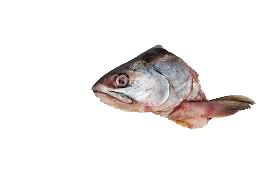

Dogs can eat fish heads and they are a great source of protein and omega-3 fatty acids. However, it is important to remove all bones before feeding them to your dog to prevent injury.
Fish heads provide protein that promotes bone, muscle, and tissue health. They also contain omega-3 fatty acids that help reduce inflammation and joint pain. Additionally, fish eyeballs can benefit a dog’s brain function.
Raw fish heads may contain parasites and bacteria if they are not sourced from a reliable supplier. The thick and sharp bones can also pose a risk to small dogs and dogs that are not used to raw feed.
To ensure safety, source fish from areas with low mercury exposure and minimal pollution. If feeding raw fish heads, supervise your dog. For small dogs and puppies, remove bones and sharp parts. Fish heads can be eaten raw or boiled, or boiled to make fish stock to add to your dog’s food.
Fish heads are the leftover parts of fish that are usually discarded. They are a good source of protein, omega-3 fatty acids, and vitamins for dogs. The bones in fish heads can also help clean their teeth and strengthen their jaw muscles. However, it is important to note that fish heads can contain bones that may splinter and cause internal damage to dogs, especially if they are not properly cooked. Additionally, some fish may contain high levels of mercury and other toxins that can be harmful to dogs. In extreme cases, ingestion of fish heads can cause choking, gastrointestinal blockages, or even death. Safer alternatives to fish heads are boneless fish fillets or canned fish in water. A serving idea for dogs is to mix cooked fish with their regular food or to serve it as a treat.
In case of extreme cases such as choking or difficulty breathing, it is important to seek immediate veterinary care. If a dog has consumed a large amount of fish heads, they may experience symptoms such as vomiting, diarrhea, or lethargy. It is important to monitor their behavior and seek veterinary care if necessary. Safer alternatives to fish heads are boneless fish fillets or canned fish in water. These options are less likely to contain bones and toxins that can be harmful to dogs.
A serving idea for dogs is to mix cooked fish with their regular food or to serve it as a treat. It is important to ensure that the fish is thoroughly cooked and that any bones are removed before feeding it to dogs. Additionally, it is important to feed fish in moderation as it should not be the main source of a dog's diet.